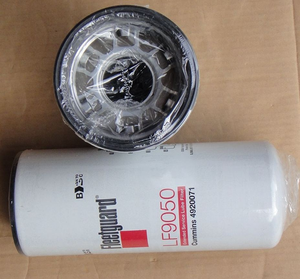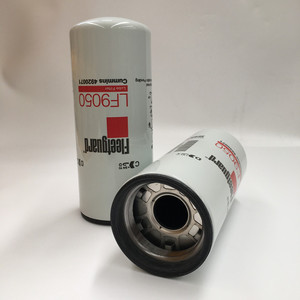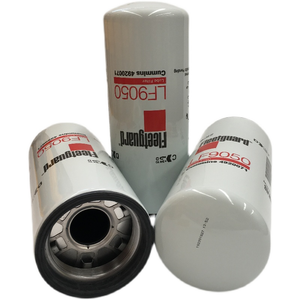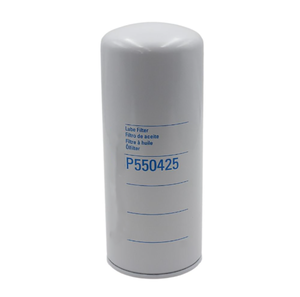(2057 products available)



















































































































































































































































A Fleetguard oil filter is a type of filter used to filter oil in internal combustion engines. There are two main types of filters, which are explained below.
These are the most common type of oil filters. The spin-on oil filter has a steel can that holds the filter material, the base plate, and the gasket. The filter material traps contaminants like dirt and debris from the oil and prevents them from damaging the engine. The oil flows from the center hole of the base plate, through the filter, and out through the small holes to the exterior of the base plate. The dirty oil then returns to the engine through the openings on the can's end. Spin-on oil filters are easy to install and change. They are also cheaper than the alternatives.
These filters have filter media in a replaceable cartridge. The cartridge fits into a housing that connects it to the engine's oil system. The housing has an inlet and an outlet for the oil, allowing it to flow through the cartridge. The cartridge traps contaminants, allowing clean oil to flow into the engine. Cartridge filters are more difficult to use, and they are more expensive. Nonetheless, they are environmentally friendly because they produce less waste. Cartridge oil filters are also designed to be more efficient when filtering oil.
When selecting a Fleetguard oil filter, it is essential to understand the specifications and how to maintain the oil filter to ensure the best performance and engine durability.
There are various specifications to consider when purchasing a Fleetguard oil filter. These include the following:
It is essential to select a Fleetguard oil filter with the right size to fit the engine. The specifications of the oil filter are indicated on the side of the oil filter. This will ensure that the oil filter fits properly.
This specification refers to the size of the thread on the oil filter. It is important to select a lf9009 with the right thread size to ensure a proper fit and a tight seal to prevent oil leaks.
This is the amount of oil that the oil filter can deliver. It is important to select a Fleetguard oil filter with the right oil flow rate to match the engine's requirements. A low flow rate can cause the oil pressure to drop, while a high flow rate can cause the oil to be filtered less.
This is the material used in the oil filter element. It is important to select a Fleetguard oil filter with the right media to trap contaminants in the oil and prevent them from entering the engine. Oil filter media are available in various sizes to trap small and large contaminants. It is also available in different materials such as cotton and synthetic fiber.
There are different types of Fleetguard oil filters, such as spin-on and cartridge filters. Spin-on filters are easy to replace and are used for light-duty applications. Cartridge filters are used for heavy-duty applications and are made of a high-quality material that increases their lifespan.
Regular oil filter maintenance is important to ensure its performance. Here are some maintenance tips for maintaining a Fleetguard oil filter:
lf14000nn filters are designed for use with different oil types, including synthetic and conventional oils. The oil filter's compatibility with different oil types is a key consideration when choosing an oil filter. Preferably, if the vehicle uses standard oil, select an oil filter that is compatible with the oil type. If the car uses synthetic oil, choose an oil filter that is compatible with the synthetic oil to ensure optimal performance and longevity.
Consider the vehicle's specifications, such as the make, model, and year of manufacture. This will help to determine the specific Fleetguard oil filter that will be compatible with the vehicle's engine. The right oil filter will fit properly and ensure that contaminants are trapped, preventing them from damaging the engine parts. Check the oil filter's compatibility chart to find out which vehicle the filter is designed for.
When selecting a Fleetguard oil filter, consider the quality and performance. High-quality oil filters, such as lf3970, can remove more contaminants from the oil, offering better protection for the engine. The oil filter's quality is often reflected in the material used to construct it. Consider oil filters made from high-quality materials like reinforced steel and high-flow filter media, which will ensure long-lasting performance.
The quality of the oil filter's seal is an important factor to consider when selecting an oil filter. The seal prevents oil from leaking out of the filter and ensures that the oil flows through the filter and into the engine. A good oil filter will have a strong, well-fitted seal that will prevent leaks and ensure that the engine is adequately lubricated. A weak seal will cause leaks and could damage the engine by causing it to overheat.
Select the right size and configuration of the Fleetguard oil filter. The oil filter's size will determine how well it fits into the engine and traps contaminants. A well-fitting oil filter will remove more contaminants, thus protecting the engine's moving parts like the pistons, camshaft, and crankshaft from wear. The oil filter's configuration will determine how easy it is to install and replace.
Replacing a Fleetguard oil filter is a simple process, but one needs the right tools. Here is a step-by-step guide on how to do it.
Q1: What is the purpose of a Fleetguard oil filter?
A1: A Fleetguard oil filter is a filter used to clean engine oil. It is usually fitted in internal combustion engines. The oil filter's primary purpose is to remove contaminants from the engine's oil. Doing this helps ensure the circulating oil is free of abrasive particles. The abrasive particles can harm engine parts with constant contact with the oil, such as piston rings, bearings, and cylinder walls. As a result, the oil filter helps increase the engine's efficiency and durability.
Q2: How often should a Fleetguard oil filter be changed?
A2: The oil filter needs to be changed regularly, typically every 3,000 to 5,000 miles. Some modern vehicles can go up to 10,000 miles before the oil filter is changed. However, the duration a used oil filter should stay in the engine depends on the vehicle's model and the type of engine. It's advisable to follow the manufacturer's recommendation on the vehicle's manual.
Q3: Can a Fleetguard oil filter prevent engine wear?
A3: Yes, it can. The Fleetguard oil filter is designed to trap contaminants that can accelerate engine wear. It ensures that the oil that circulates in the engine is free of contaminants. This helps protect the engine parts and promote their durability.
Q4: Do Fleetguard filters use cellulose media?
A4: Yes, some Fleetguard filters use cellulose media. The Fleetguard oil filter contains a fine mesh of cellulose fibers. The cellulose fibers are capable of trapping particles as small as 20 microns. They are effective at removing contaminants from the oil. Some Fleetguard oil filters use a mix of cellulose and synthetic media, providing enhanced filtration and extended service life.